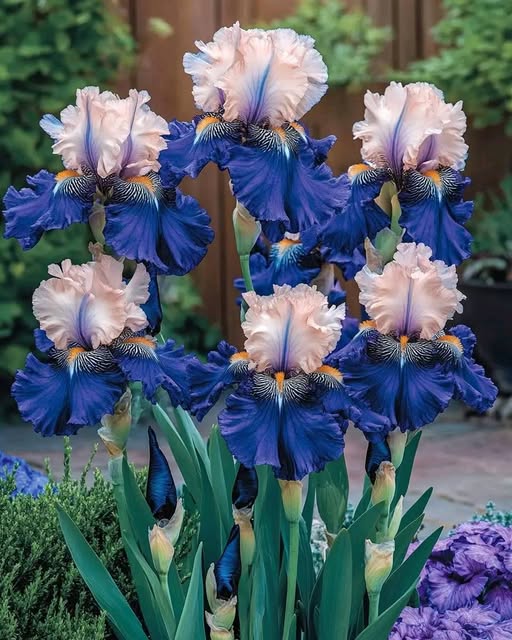The Iris ‘Ocean Deep’ is a stunning cultivar that brings a sophisticated and serene aesthetic to any garden. With its deep blue and violet hues, this iris variety captures the beauty of the ocean in full bloom, making it a perfect choice for garden enthusiasts looking to create a calming and colorful space. Whether you’re a seasoned gardener or a beginner, this hardy perennial offers a spectacular display that adds vibrancy, elegance, and texture to your landscape. Below is a detailed guide on growing, caring for, and styling the Iris ‘Ocean Deep’ in your garden.
The Alluring Beauty of Iris ‘Ocean Deep’
The Iris ‘Ocean Deep’ is known for its rich, deep blue and violet-colored flowers that resemble the vast and tranquil depths of the ocean. This variety stands out among other irises due to its dramatic color contrast, making it an eye-catching plant that captures attention in garden beds or borders. Typically growing 24 to 36 inches tall, this iris variety produces tall, graceful stems adorned with several large, ruffled flowers in late spring to early summer.
The flowers themselves are large, with delicate frilled edges that create a stunning contrast against the vibrant petals. This type of iris is especially beloved by gardeners for its graceful appearance and long-lasting blooms that remain fresh for an extended period. Because of its elegant color, it can complement a wide range of garden themes, whether you’re designing a romantic cottage garden or a more structured, formal landscape.
Growing Conditions for Iris ‘Ocean Deep’
To ensure your Iris ‘Ocean Deep’ thrives and produces its gorgeous blooms year after year, providing the right growing conditions is key. Here are the optimal conditions you should aim for:
1. Light Requirements:
Iris ‘Ocean Deep’ requires full sun to grow successfully. This means that the plant needs at least 6 hours of direct sunlight per day. Without proper sunlight, the iris may fail to bloom and its growth could be stunted.
If you live in a hotter climate, it’s advisable to plant your irises where they will receive partial afternoon shade to avoid scorch from the intense midday sun, while still ensuring they get ample morning sunlight.
2. Watering:
Iris plants are relatively drought-tolerant once established, but they do require moderate watering to support healthy growth and flowering. Ensure the soil remains moist but not soggy.
Overwatering is one of the primary causes of issues like root rot, so make sure the soil drains well and doesn’t hold excess water. Water thoroughly when the top inch of the soil feels dry, but avoid keeping the roots sitting in stagnant water.
3. Soil Conditions:
Iris ‘Ocean Deep’ thrives in well-draining, fertile soil. To ensure your plant grows successfully, it’s crucial to provide soil that allows water to flow through freely but retains enough moisture to keep the roots hydrated.
Amend heavy or clay-based soils with compost or organic matter to improve drainage. If your soil is sandy, incorporate some compost or loamy soil to increase its fertility and moisture retention.
4. Temperature and Hardiness Zones:
This iris variety is well-suited for temperate regions and is hardy in USDA zones 3-9. It can handle a bit of frost, but for warmer climates, it’s best to provide some afternoon shade to prevent the flowers from wilting under extreme heat.
Planting Iris ‘Ocean Deep’
Planting Iris ‘Ocean Deep’ is an easy and straightforward process. Follow these steps to ensure your irises have the best possible start:
1. Prepare the Soil:
Choose a well-draining, sunny spot in your garden. Make sure the soil is fertile and free of any weeds.
If your soil is compacted or not draining well, amend it with compost to loosen it up and improve fertility.
2. Planting Depth:
Place the rhizomes (the thick, underground stems) at a depth of about 2 inches below the soil surface. Make sure the top of the rhizome is just above soil level. Planting the rhizomes too deep can lead to poor growth and reduced flowering.
3. Spacing:
Plant the Iris ‘Ocean Deep’ rhizomes about 12 to 18 inches apart to allow for proper airflow and room for growth. These plants need space to spread, as they can multiply each year.
Caring for Iris ‘Ocean Deep’
Once established, the Iris ‘Ocean Deep’ is relatively low maintenance. However, to help it thrive and encourage abundant blooms, there are a few care steps to follow:
1. Fertilizing:
In early spring, apply a balanced fertilizer to give your irises the nutrients they need to start growing and blooming. A slow-release granular fertilizer works well.
Be cautious not to over-fertilize, as excessive nitrogen can cause more foliage growth at the expense of blooms. Fertilize only once per year, just before the growing season begins.
2. Mulching:
After planting, mulch around the base of the plant to help retain moisture, regulate soil temperature, and reduce weed growth. However, avoid piling mulch directly over the rhizomes, as this can promote rot.
3. Pruning:
Once the flowers have faded, remove the spent flower stalks to keep the plant looking tidy. Cut the stems down to the ground once they have finished blooming.
You can also prune dead or damaged foliage throughout the growing season to help the plant conserve energy for its next bloom.
4. Dividing:
Every 3 to 5 years, iris plants should be divided to prevent overcrowding and maintain healthy growth. The best time to divide your irises is in late summer after they have finished blooming.
To divide, dig up the rhizomes, separate them carefully, and replant them in new spots, ensuring each division has at least one healthy rhizome and a bit of foliage.
Common Pests and Problems
Iris plants are relatively pest-resistant, but there are a few things to watch out for:
1. Iris Borer:
Iris borers are a common pest that can damage the leaves and roots. To prevent this, remove dead foliage and keep the garden clean.
2. Aphids:
Occasionally, irises may attract aphids. If you notice aphids, gently hose down the plant with water or use insecticidal soap.
3. Root Rot:
Root rot is a common problem caused by overwatering or poor drainage. Ensure the soil is well-draining, and avoid watering too frequently.
Design Tips for Using Iris ‘Ocean Deep’ in Your Garden
The Iris ‘Ocean Deep’ can be an excellent addition to any garden design. Here are some ways to incorporate this stunning iris into your landscape:
1. Garden Borders:
Planting this iris along the edges of your garden beds or in a designated border will create an elegant and structured look. Its tall stems and vibrant color will add visual height and interest.
2. Mixed Garden Planting:
Combine Iris ‘Ocean Deep’ with other perennials such as daylilies, peonies, or roses to create a multi-textured, colorful garden. Pairing irises with plants that have different blooming times ensures continuous beauty throughout the growing season.
3. Cut Flower Arrangements:
The blooms of Iris ‘Ocean Deep’ make for beautiful cut flowers. Their tall stems and large, ruffled blooms are perfect for spring and summer bouquets, adding elegance to your home’s interior.
Conclusion:
Iris ‘Ocean Deep’ is more than just a beautiful plant—it’s a statement piece for any garden. With its deep, oceanic colors, easy care requirements, and versatility, it offers both seasoned gardeners and beginners a chance to enhance their garden spaces. Whether used in borders, mixed plantings, or cut arrangements, this iris variety will continue to reward you with stunning blooms year after year. So, if you’re looking for a plant that will fill your garden with serenity, elegance, and vibrant color, Iris ‘Ocean Deep’ is the perfect choice.
More Articles You Might Like
-
Texas Toast Sloppy Joes: The Crunchy, Cheesy Upgrade You Didn’t Know You Needed
There’s something timeless about sloppy joes. For generations, this saucy, savory, and slightly sweet ground beef sandwich has been a go-to comfort food in American kitchens. It’s quick, filling, and family-friendly—perfect for busy weeknights. But what if we told you there’s a way to take this classic dish up a notch? Enter the Texas Toast…
-
Classic Pig Pickin’ Cake
When it comes to Southern desserts, few sweets shine as brightly as the Classic Pig Pickin’ Cake. This nostalgic cake, sometimes called a “Mandarin Orange Cake,” has roots deep in Southern tradition. It gets its playful name from its frequent appearance at pig pickin’s—Southern-style barbecue gatherings where communities come together to enjoy slow-cooked pork, sides,…
-
Lemon Garlic Butter Chicken with Creamy Parmesan Pasta
There’s something irresistible about the combination of tender, golden-browned chicken paired with a creamy pasta coated in Parmesan cheese. Add the brightness of lemon, the depth of garlic, and the richness of butter, and you have a recipe that feels indulgent yet approachable enough for a weeknight dinner. Lemon Garlic Butter Chicken with Creamy Parmesan…



